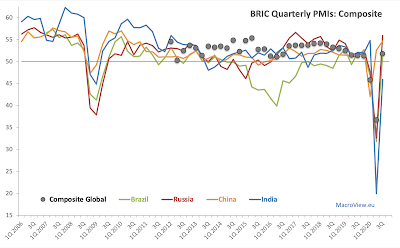BRIC Manufacturing has rebounded strongly from thee pandemic lows, as covered in this post here: https://trueeconomics.blogspot.com/2020/10/141020-bric-manufacturing-pmis-q3.html. Services PMI for the BRIC economies signal similar, albeit weaker rebound in July-September:
Brazil Services PMI stayed in the recession territory in 3Q 2020, with index reading coming in at 47.5, up on 30.3 in 2Q 2020, but still marking a third consecutive quarter of sub-50 readings. Put simply, unlike manufacturing that is showing rather incredible signs of the recovery, Brazil's services sectors continue to show ongoing contraction, building on 6 consecutive months of contracting activity through August 2020. September monthly reading at 50.4 is statistically indistinguishable from zero growth line of 50.0. In summary, Brazil's services sector is not in a recovery so far.
Russia Services PMI posted very strong recovery signals in 3Q 2020, although September reading slipped to 53.7 (fast growth) from blistering 58.5 and 58.2 in July and August, respectively. 3Q 2020 Russia Services PMI was at 56.8 marking a sharp turnaround from 36.0 in 2Q 2020. This is the fastest pace of quarterly expansion since 1Q 2017.
India Services PMI remains in contraction, with 3Q 2020 reading of 41.9, an improvement on sharper rates of deterioration in 2Q 2020 at 17.2. September marked seventh consecutive month of sub-50 readings in Services sector in India.
China Services PMI came in at 54.3 in 3Q 2020, up on 52.6 in 2Q 2020, marking second consecutive quarter of recovery from the pandemic lows of 1Q 2020 when the index fell to 40.4.
Overall, BRIC Services Activity Index - an index compiled by me based on GDP shares and Markit monthly PMI data - rose from 40.4 in 2Q 2020 to 51.0 in 3Q 2020. Given the nature of PMIs as signals of monthly changes in activity, 3Q 2020 reading is consistent with the BRIC block services sectors recovering only partially from the pandemic lows. BRIC Services Activity Index ended 3Q 2020 at the levels slightly below the Global Services PMI which stood at 51.4. Global services sectors are also showing more rapid rate of quarterly recovery, rising from 35.6 in 2Q 2020 to 51.4 in 3Q 2020.


















